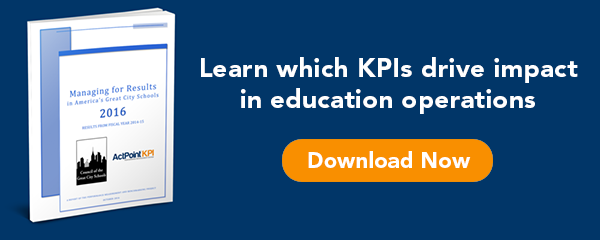 The value of tracking operational key performance indicators (KPIs) stretches beyond maximizing return on investment (ROI) or influencing student achievement. The effective tracking and use of KPIs can also help school districts mitigate an impending budget crisis by making strategic and logical staffing and budget cuts.
The value of tracking operational key performance indicators (KPIs) stretches beyond maximizing return on investment (ROI) or influencing student achievement. The effective tracking and use of KPIs can also help school districts mitigate an impending budget crisis by making strategic and logical staffing and budget cuts.
In many cases, the KPIs that render value for balancing the budget also influence ROI and student achievement. Costs associated with custodial workload and building condition are two operational considerations that can impact budgetary requirements.
Below, we look at an example of a school district that avoided a budget crisis and saved critical teaching positions through the strategic tracking of KPIs.
Realizing Budget and Staffing Efficiencies with KPIs
In 2012, Mr. Darin Hargraves, Director of Maintenance and Operations at the Anchorage School District, displayed the value of tracking KPIs.
The Anchorage School District asked Mr. Hargraves to reduce the custodial employee cost by $2 million and the custodial supplies and equipment budgets by 20%. In terms of employees, this meant a 10% reduction in custodial staffing (37.5 employees).
By using a strategic methodology and data analysis, Mr. Hargraves made the most equitable and efficient cuts possible. Mr. Hargraves established a KPI evaluation process and determined which employees were least critical. The process helped cut close to $2.2 million – or approximately 13% – from the budget and preserved a high level of service from the custodial workforce. The effort also saved 25 teaching positions in his district.
“The big thing to mitigate in terms of lowering your costs is your labor,” Mr. Hargraves says. “The only way you’re going to do that is to try and make employees more efficient.”
Mr. Hargraves utilized different types of information and benchmarks to help make operational decisions. He found many of the benchmarks through ActPoint KPI and also built his own tools to help with building-by-building benchmarking.
Throughout the process, Mr. Hargraves focused on four valuable KPIs:
1. Custodial Workload. Measuring custodial workload, or the number of square feet worked per custodian, can help determine if custodians work efficiently and at the proper staffing levels.
2. Custodial Cost Per Student. This measure determines if custodial cost structure is in-line with the student population.
3. Custodial Cost per Square Foot. Similarly, this measure determines if custodial cost structure is in-line with the size of a building or district.
4. Cleanliness. Mr. Hargraves surveyed operations personnel, principals, teachers and parents to measure the cleanliness of district buildings. Districts can use the APPA’s cleanliness standards to clearly evaluate cleanliness.
This KPI-based evaluation process allowed Mr. Hargraves to make logical and strategic staffing and budget adjustments. He also established a process to mitigate future budget issues.
Mr. Hargraves’ adjustments included changing the job description of the grounds crew to make the workers roles more generalist in scope. Previously confined to specific jobs like grass cutting and snow removal, the change allowed grounds crew members to augment other teams and work on more non-technical tasks, like painting and filter replacement.
“I did a study showing that instead of snow removal being the primary function of that department, it was instead to augment other departments but still perform snow removal when it snowed,” Mr. Hargraves explains.
As displayed by the Anchorage School District, evaluating KPIs can help determine how to best allocate district resources and improve operational efficiencies.





